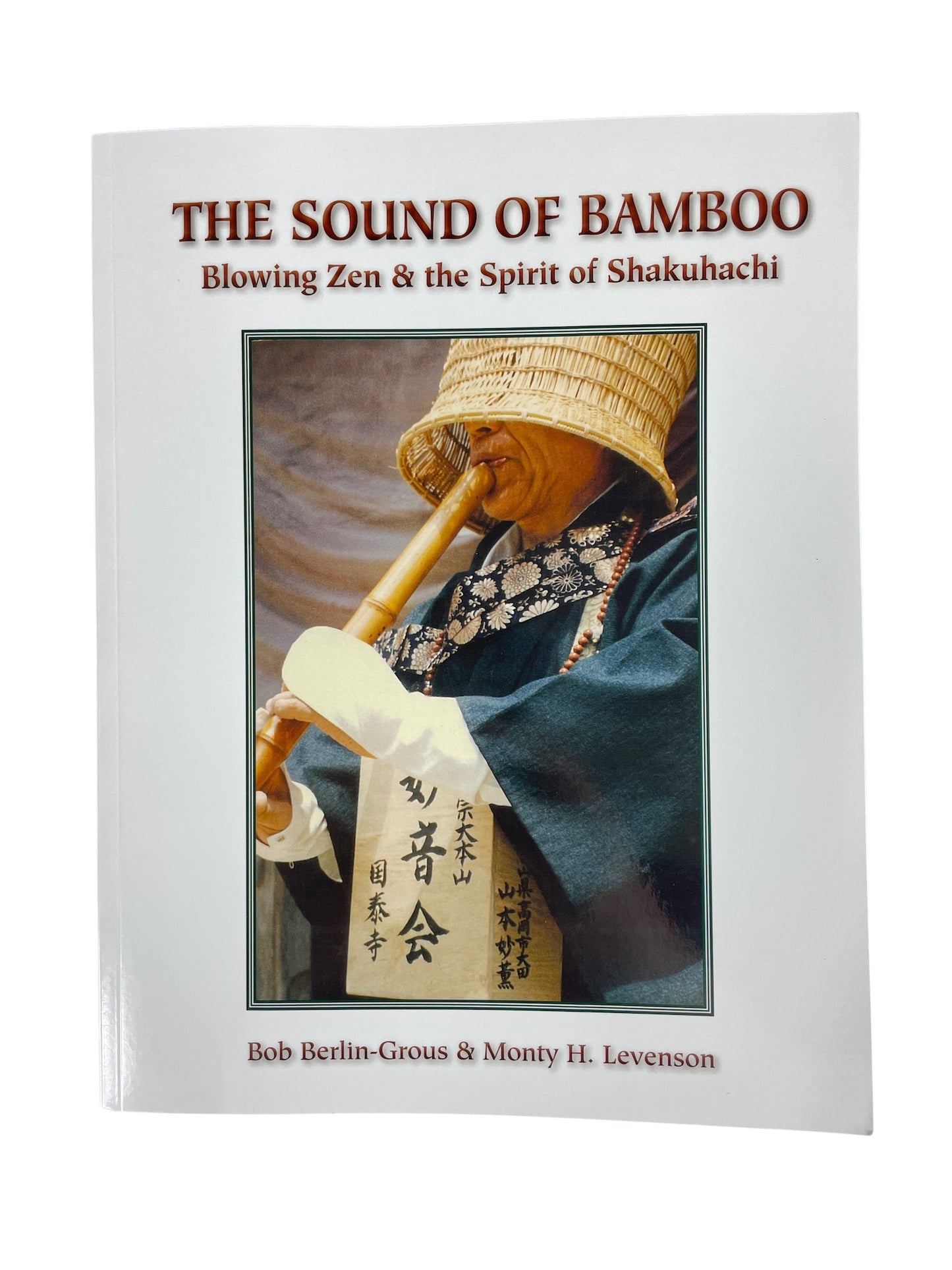Lark in the Morning
The Sound of Bamboo: Blowing Zen and the Spirit of Shakuhachi, 2nd edition
The Sound of Bamboo: Blowing Zen and the Spirit of Shakuhachi, 2nd edition
SKU:BOK706
Couldn't load pickup availability
by Bob Berlin-Grous & Monty H. Levenson with Clifton Karhu & Taniguchi Ryudo Yoshinobu
[This is an interactive book that connects directly to the Internet via Ricoh's innovative new Clickable Paper technology. An app on your phone augments the reading experience with rich video and sound.]
The Sound of Bamboo provides an expansive overview of the shakuhachi, a traditional Japanese bamboo flute dating back to the 7th Century, and its close association with Zen Buddhism as a vehicle for meditation.
The first section of the book, Shakuhachi: A Journey of Discovery, was written by Bob Berlin-Grous over four decades ago, between 1974 and 1980, when he studied shakuhachi koden and koten honkyoku with the renowned teacher Sato Seibi, and Zen Buddhist philosophy with Abe Masao. Originally published in 2013, this revised edition has been greatly expanded, updated, and edited by Monty Levenson in the new 2019 interactive edition.
Bob's comprehensive work is far more than a personal narrative. It is a thoroughly-researched treatise providing a complete overview of shakuhachi in its relationship to Japanese culture and foundation in Zen Buddhism. The initial part starts out with a description of the craft of the shakuhachi, exploring every aspect of how the instrument is traditionally made by craftsmen in Japan. Each step in the process is carefully documented. Selection and harvesting of madaké bamboo in the grove is followed by information detailing all aspects of the traditional craft.
Chapter 2 explores the Japanese sense of sound, describing the unique acoustical sensibilities deeply embedded in Japanese culture, language and physiology. Bob explains how the shakuhachi's tonal variability and association with nature embodies nuanced ways of perceiving the world, making is a perfect vehicle for spiritual practice and aesthetic expression.
A review of the historical evolution of the instrument and its traditional music is followed with a detailed analysis of shakuhachi honkyoku from both a Western analytical and Japanese perspectives on music theory. The piece Hi Fu Mi Cho is analyzed phrase-by-phrase in order to shed light on the structure and tonal phrasing of honkyoku music. Other more contemporary forms of Japanese music such as Gaikyoku, Juita and Shinkyoku or New Music are also covered in this chapter.
The final chapter presents an exhaustive discussion of the religious foundations of shakuhachi and honkyoku music and their association with Zen Buddhism in the hands of Komuso priests of the Fuke tradition.
Included in the book are beautiful and inspiring Zen- and shakuhachi-themed Japanese sumi-e ink brush paintings by two renowned artists—Clifton Karhu and Taniguchi Ryudo Yoshinobu—published for the very first time in this edition.
The final section, Stalking the Wild Bore, Monty Levenson expands and broadens his analysis of the acoustical physics of the shakuhachi—an effort to unravel the mystery of how breath is transformed into its remarkably resonant and nuanced sound.
The Sound of Bamboo is something entirely new and different in how information is transmitted, imparted, and otherwise conveyed. Embedded in pages of the book is a fourth section composed of hyperlinks that open a portal to the wide and wonderful world of shakuhachi. Access to this deep repository of information is provided directly from the book via interactive web links, audio music files, and multimedia video content. The links introduce you to many of the foremost shakuhachi players and master teachers in Japan and around the world, sharing with readers their invaluable, diverse, and unique perspectives, and gracing you with performances of their deeply moving music. Unlike any other printed book, content and enhancements are continually being added, so The Sound of Bamboo will never become outdated.
The edition is made possible by the encouragement extended by Ricoh USA, Inc. and Ricoh Company Ltd. of Japan with support by the Graphic Communication Institute at Cal Poly State University in San Luis Obispo, California.
Ricoh’s collaboration with Tai Hei Shakuhachi on the project showcases their innovative interactive Clickable Paper technology—a new way of learning and communicating via print—that essentially turns a printed book into the equivalent of a web browser with video and sound. The Sound of Bamboo is one of only two books in the world written and published using this innovative new technology. It also testifies to Ricoh’s commitment and dedication to expand awareness of traditional Japanese culture worldwide, thereby helping to perpetuate its rich and venerable heritage.
The free Clickable Paper app maximizes the reader's experience in learning and better understanding concepts and processes by making print come alive and enhanced via multimedia content. It is based on the concept that people learn and understand in different ways. Some learn best by reading, some by videos, some by hearing, and some by a combination of these venues. Clickable Paper provides all of these experiences.
The Sound of Bamboo demonstrates Ricoh's Clickable Paper as an Augmented Reality (AR) application that brings to life a “Japanese experience” through music, culture, learning, and training via web pages, videos, and sound. A printed book or other form of print media can now be embedded with multiple hotspots linked to one or multiple sources, instantly taking readers from two-dimensional printed content to online, multi-channel content. iOS and Android mobile apps are free to download and easy to use. One tap on a smart phone aimed at an embedded page opens the reader to the World Wide Web via hyperlinks put in place by the author.
The beauty of this new interactive technology goes beyond broadening the informational parameters of a printed book. It also allows an edition to be expanded and enhanced past the date of its initial publication. Like any online website, linked content can and will be updated or otherwise modified well into the future, keeping a book relevant and up to date. And finally, it encourages interaction amongst readers, authors, and others by opening channels of communication within a community of interest.
Encyclopedic in scope, The Sound of Bamboo includes over 100 photos, illustrations, and artwork as well as 400 hyperlinks connecting the reader from the printed page directly to the world of shakuhachi via the Internet.
173 pages PG-24
Share


Look Out For Our Unique Instruments In Andre 3000's New Album
Andre 3000 found inspiration in our one-of-a-kind instruments to create the groundbreaking sounds of his newest album.
- Choosing a selection results in a full page refresh.
- Opens in a new window.

This chieftain ain’t bad. I would say situated in between intermediate and professional grade. A little bit thick but not too thick. I’m happy with this purchase

The skins are as beautiful as can be expected. I'll be using them for canvas in an art project in 2026. I'll be a returning customer.

I bought this 30 inch frame drum about 3 years ago (2022 I think) for use in drum circles and also for recording. It’s incredible! I wanted a drum that people could not just hear, but also feel. This one fulfills that promise very powerfully, so I call it the Boneshaker. I’ve gotten a ton of compliments about it at drum circles. It helps to hold the rhythm together very well. By playing the drum harmonics, I can find at least 3 tones to it, more depending on how I tune it. I’ve had dozens of drums and over a hundred percussion instruments over the years, but this is in the top 1% of my all time favorites. I even painted the head and it’s beautiful! Everyone at the drum circles loves it.

I bought this bodhran after I broke my more decorative one while protesting. I’m one of four women who are Drumming for Democracy every week at our local Saturday protest.

The DG-255 I received from Lark in the Morning was easily as beautiful as presented. The padded gig bag is a huge plus as well.
The guitar is a solid and has a bigger, more forward sound than I'd anticipated which suits me just fine. It plays easily, surely even more so after I have a guitar tech get it set up for me.
Nice people, excellent service, quick shipping. Nothing not to like here.

